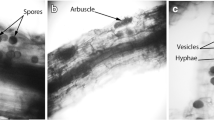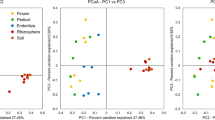Abstract
The occurrence of uncultivated Frankia was evaluated in Tunisian soils by a plant-trapping assay using Coriaria myrtifolia seedlings. Despite the lack of this compatible host plant for more than two centuries, soil-borne Frankia cells were detected in one sampled soil as shown by the development of root nodules on 2-year-old seedlings. Based on glnA sequences, Tunisian trapped Frankia strains belong to the uncultivated cluster 2 strains that associate with other Coriaria species and also with Ceanothus, Datisca and Rosaceae actinorhizal species. This is the first report on the occurrence of Frankia cluster 2 strains in soils from areas lacking compatible host plant groups.


Similar content being viewed by others
References
Alapetite GP 1979 Flore de la Tunisie. Edition du Ministère de l’enseignement supérieur et de la recherche scientifique et du Ministère de l’agriculture. République Tunisienne
Benecke U 1969 Symbionts of alder nodules in New Zealand. Plant Soil 30 145–149
Benson DR and Clawson ML 2000 Evolution of the actinorhizal plant symbioses; In Prokaryotic nitrogen fixation: A model system for analysis of biological process (ed) EW Triplett (Wymondham, UK: Horizon Scientific Press) pp 207–224
Benson D R, Vanden Heuvel BD and Potter D 2004 Actinorhizal symbioses: diversity and biogeography; in Plant microbiology (ed) M Gillings (Oxford: BIOS Scientific Publishers Ltd.) pp 97–127
Berry AM and Sunell LA 1990 The infection process and nodule development; in The biology of Frankia and actinorhizal plants (eds) CR Schwintzer and JD Tjepkema (San Diego: Academic Press, Inc.) pp 61–81
Burgess D and Peterson RL 1987 Development of Alnus japonica root nodules after inoculation with Frankia strain HFPArI3. Can. J. Bot. 65 1647–1657
Canizo A and Rodriguez-Barrueco C 1978 Nitrogen fixation by Coriaria nepalensis Wall. Rev. Ecol. Biol. Sol 15 453–458
Chaia EE, Wall LG and Huss-Danell K 2010 Life in soil by the actinorhizal root nodule endophyte Frankia. A review. Symbiosis 51 201–226
Clawson ML, Bourret A and Benson DR 2004 Assessing the phylogeny of Frankia actinorhizal plant nitrogen-fixing root nodule symbioses with Frankia16S rRNA and glutamine synthetase gene sequences. Mol. Phylogenet. Evol. 31 131–138
Felsenstein J 1985 Confidence limits on phylogenies: an approach using the bootstrap. Evolution 39 783–791
Good RDO 1930 The geography of the genus Coriaria. New Phytol. 29 170–198
Gtari M and Dawson JO 2011 An overview of actinorhizal plants in Africa. Funct. Plant Biol. 38 653–661
Gtari M, Brusetti L, Skander G, Mora D, Boudabous A and Daffonchio D 2004 Isolation of Elaeagnus-compatible Frankia from soils collected in Tunisia. FEMS Microbiol. Lett. 234 349–355
Mirza MS, Hameed S and Akkermans AD 1994 Genetic diversity of Datisca cannabina-compatible Frankia strains as determined by sequence analysis of the PCR-amplified 16S rRNA gene. Appl. Environ. Microbiol. 60 2371–2376
Montserrat P 1958 Root nodules of Coriaria. Nature 182 475
Newcomb W and Pankhurst CE 1982 Fine structure of actinorhizal root nodules of Coriaria arborea (Coriariaceae) New Zealand J. Bot. 20 93–103
Nick G, Paget E, Simonet P, Moiroud A and Normand P 1992 The nodular endophytes of Coriaria spp. form a distinct lineage within the genus Frankia. Mol. Ecol. 1 175–181
Normand P, Orso S, Cournoyer B, Jeannin P, Chapelon C, Dawson J, Evtushenko L and Misra AK 1996 Molecular phylogeny of the genus Frankia and related genera and emendation of the family Frankiaceae. Int. J. Syst. Bacteriol. 46 1–9
Nouioui I, Ghodhbane-Gtari F, Beauchemin NJ, Tisa LS and Gtari M 2011 Phylogeny of members of the Frankia genus based on gyrB, nifH and glnII sequences. Antonie Van Leeuwenhoek 100 579–587
Persson T, Benson DR, Normand P, Vanden Heuvel B, Pujic P, Chertkov O, Teshima H, Bruce DC, et al. 2011 Genome sequence of “Candidatus Frankia datiscae” Dg1, the uncultured microsymbiont from nitrogen-fixing root nodules of the dicot Datisca glomerata. J. Bacteriol. 193 7017–7018
Ritchie NJ and Myrold DD 1999 Geographic distribution and genetic diversity of Ceanothus-infective Frankia strains. Appl. Environ. Microbiol. 65 1378–1383
Rodriguez-Barrueco C 1968 The occurrence of the root nodule endophytes of Alnus glutinosa and Myrica gale in soils. J. Gen. Microbiol. 52 189–194
Rodriguez-Barrueco C, Sevillano F and Nebreda TM 1988 Effective nodulation of Coriaria myrtifolia L. induced by Frankia strains from Alnus glutinosa L. (Gaertn.). Plant Soil 110 167–176
Saitou N and Nei M 1987 The neighbor-joining method: a new method for reconstructing phylogenetic trees. Mol. Biol. Evol. 4 406–425
Silvester WB and Harris SL 1989 Nodule structure and nitrogenase activity of Coriaria arborea in response to varying pO2. Plant Soil 118 97–109.
Smolander A and Sundman V 1987 Frankia in acid soils of forests devoid of actinorhizal plants. Physiol. Plant. 70 297–303
Wollum AG II, Youngberg CT and Chichester FW 1968 Relation of previous timber stand age to nodulation of Ceanothus velutinus. Forest Sci. 14 114–118
Zimpfer JF, Kennedy GJ, Smyth CA, Hamelin J, Navarro E and Dawson JO 1999 Localization of Casuarina-infective Frankia near Casuarina cunninghamiana trees in Jamaica. Can. J. Bot. 77 1248–1256
Acknowledgements
The study was partially supported by funding from the Comité Mixte de Coopération Universitaire, France-Tunisie (grant EGIDE-CMCU no.10G0903), and by the Comité Mixte Permanent Tuniso-Marocain pour la Recherche Scientifique et la Technologie (CMPTM no. 10/MT/14).
Author information
Authors and Affiliations
Corresponding author
Additional information
[Nouioui I, Sbissi I, Ghodhbane-Gtari F, Benbrahim KF, Normand P and Gtari M 2013 First report on the occurrence of the uncultivated cluster 2 Frankia microsymbionts in soil outside the native actinorhizal host range area. J. Biosci. 38 1–4] DOI 10.1007/s12038-013-9366-z
Rights and permissions
About this article
Cite this article
Nouioui, I., Sbissi, I., Ghodhbane-Gtari, F. et al. First report on the occurrence of the uncultivated cluster 2 Frankia microsymbionts in soil outside the native actinorhizal host range area. J Biosci 38, 695–698 (2013). https://doi.org/10.1007/s12038-013-9366-z
Published:
Issue Date:
DOI: https://doi.org/10.1007/s12038-013-9366-z




